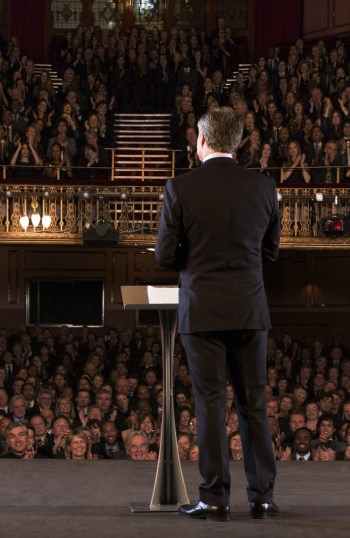the study we’re going to cover proves that a bad first impression can make three-quarters of your audience – 74% to be exact – no longer interested in your performance!
First impressions matter – and they matter a lot!
You can be an excellent speaker, performer or entertainer – it doesn’t matter.
When you stand in the public limelight your first set of actions and behaviors can create new adoring fans or fan the flames of skeptics and critics.
We form an opinion about a person before he even get’s the chance to unleash his talents on his audience?
Just picture this for yourself and see how you react to these two speakers:
A well-dressed speaker strides confidently onto the stage, grasps the microphone firmly, makes eye-contact with the audience and starts his speech;
or
A speaker in a rumpled jacket and mismatched socks stumbles up the stairs of the stage and makes his way awkwardly to the microphone, taps it uncertainly and making sure it’s working takes a few memorization cards out of his pocket and starts talking;
With a few possible exceptions, we all make these judgment and there is evidence to back it up
A study was created and published on the music research journal Musicae Scientiae in 2013 over at Hanover University of Music in Germany.
The study investigated how a person’s entrance and how they walked onto the stage can have a lasting impression on an audience.
The results? Well, they are going to surprise to you.
What will cause you to raise your eyebrows is how conclusive the findings were.
1. How the Data Was Collected – Audience Impressions Related To Your Entrance
The researchers specifically concentrated on violin performers and how they were judged while making their entrance.
The goal of the study was to identify what impression audiences gained from the way a musician enters the stage before performing.
More specifically researchers were trying to establish just how much a first impression can positively or negatively impact someone’s reception by an audience – regardless of the actual performance.

How Was The “Audience & Lasting Impression Study” Conducted
The study was divided into three parts:
1. The first portion took place at the Hanover Joseph Joachim International Violin Competition in 2009 where each violinist performed for the competition and were asked to fill out a simple survey.
The performance was videotaped from multiple camera angles but the actual performance was cut out leaving only the performer’s entrance.
2. The second part of the study consisted of 200 participants judging the performer’s entrance who were each shown a random sample of the stage entrance videos to judge.
3. The researchers then analysed the results by concentrating on some key behavioral traits the performers exhibited.
The most important elements the performers were judged on was the following:
- How often the performer nodded to the audience
- The width of the performer’s stance
- The likability of the performer
- How confident the performer seemed
- The direction of the performer’s gaze
- Have fast the performer walked to the front of the stage
- How often the performer changed the direction of his/her gaze
- The performer’s resoluteness
- How often the performer touched themselves (their clothes, messed with their hair, etc.)
- Step size used to enter the stage
2. Audience Reaction To Strong & Weak Entrances – What Were The Results?
With the sample data in hand the researchers wanted to dive further into understanding the power of a strong or weak entrance.
They did this by bringing in around 1000 people to be studied as they judged musicians.
They used the same technique as before so each participant was randomly shown one of the pre-recorded stage entrances and then filled out a questionnaire using the 10 elements above.
But this time the judges were asked a different question:
Would you like to continue watching that performer’s piece?
Based on the statistics gathered researchers classified the performers’ entrances as follows:
- Appropriate – This was considered a good entrance
- Acceptable – This was seen as an average rating
- Inappropriate – This was a bad rating
Now that they’d grouped the performers based on their entrance, the researchers cross-referenced that with whether participants wanted to continue watching the performer’s piece.
Even the researchers were stunned by the results:
| Judges did not want to watch their performance | Judges wanted to watch their performance | |
| Appropriate | 8.1% | 91.9% |
| Acceptable | 35.8% | 64.2% |
| Inappropriate | 74.0% | 26.0% |
Yeah – you read that right.
If you have a bad entrance, it doesn’t matter how well you play your instrument, speak, teach, or perform.
Three-quarters of people are going to start to tune you out.
74% no longer want to watch you!

Importance Of A Solid Entrance
3. The Power Of Your Entrance – What This Means For You
So who cares what some stuffy scientists found out about people who play the violin.
This doesn’t apply to me……..right?
Wrong.
The judges selected were general members of the public.
This means they’re the same type of people who may be sitting in the audience when you give your business presentation.
They comprise the same people who’ll be paying attention at that meeting at your work.
Or that group of ladies at the bar or club you frequent.
The take-home information for you is this:
A bad first impression means that as much as 74% of the people you meet are no longer interested in what you have to say.
It doesn’t matter how great you perform at work or how good your social skills are or how compelling your business idea is – if you mess up that first impression there is a good chance you’ll be judged before you get to prove yourself.
So if you had any doubts whatsoever that it’s crucial to dress well and be presentable you can lay them to rest.
Source: http://www.realmenrealstyle.com/importance-good-entrance/








